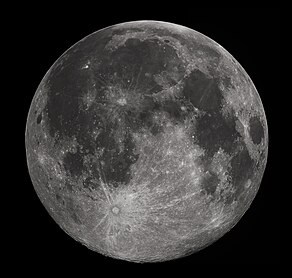Moon

Full Moon as seen from Earth's northern hemisphere
|
|||||||||||||
| Designations | |||||||||||||
|---|---|---|---|---|---|---|---|---|---|---|---|---|---|
| Adjectives |
|
||||||||||||
| Orbital characteristics | |||||||||||||
| Perigee |
362600 km (356400–370400 km) |
||||||||||||
| Apogee |
405400 km (404000–406700 km) |
||||||||||||
| 384399 km (0.00257 AU) | |||||||||||||
| Eccentricity | 0.0549 | ||||||||||||
|
29.530589 d
(29 d 12 h 44 min 2.9 s) |
|||||||||||||
|
Average orbital speed
|
1.022 km/s | ||||||||||||
| Inclination | 5.145° to the ecliptic | ||||||||||||
|
Regressing by one revolution in 18.6 years
|
|||||||||||||
|
Progressing by one revolution in 8.85 years
|
|||||||||||||
| Satellite of | Earth | ||||||||||||
| Physical characteristics | |||||||||||||
|
Mean radius
|
1737.1 km (0.273 Earths) | ||||||||||||
|
Equatorial radius
|
1738.1 km (0.273 Earths) | ||||||||||||
|
Polar radius
|
1736.0 km (0.273 Earths) | ||||||||||||
| Flattening | 0.0012 | ||||||||||||
| Circumference | 10921 km (equatorial) | ||||||||||||
| 3.793×107 km2 (0.074 Earths) | |||||||||||||
| Volume | 2.1958×1010 km3 (0.020 Earths) | ||||||||||||
| Mass | 7.342×1022 kg (0.012300 Earths) | ||||||||||||
|
Mean density
|
3.344 g/cm3 0.606 × Earth |
||||||||||||
| 1.62 m/s2 (0.1654 g) | |||||||||||||
| 0.3929±0.0009 | |||||||||||||
| 2.38 km/s | |||||||||||||
|
Sidereal rotation period
|
27.321661 d (synchronous) | ||||||||||||
|
Equatorial rotation velocity
|
4.627 m/s | ||||||||||||
|
|||||||||||||
| Albedo | 0.136 | ||||||||||||
|
|||||||||||||
|
|||||||||||||
| 29.3 to 34.1 arcminutes | |||||||||||||
| Atmosphere | |||||||||||||
|
Surface pressure
|
|||||||||||||
| Composition by volume | |||||||||||||
The Moon is an astronomical body that orbits planet Earth, being Earth's only permanent natural satellite. It is the fifth-largest natural satellite in the Solar System, and the largest among planetary satellites relative to the size of the planet that it orbits (its primary). Following Jupiter's satellite Io, the Moon is second-densest satellite among those whose densities are known.
The average distance of the Moon from the Earth is 384,400 km (238,900 mi), or 1.28 light-seconds.
The Moon is thought to have formed about 4.51 billion years ago, not long after Earth. There are several hypotheses for its origin; the most widely accepted explanation is that the Moon formed from the debris left over after a giant impact between Earth and a Mars-sized body called Theia.
The Moon is in synchronous rotation with Earth, always showing the same face, with its near side marked by dark volcanic maria that fill the spaces between the bright ancient crustal highlands and the prominent impact craters. It is the second-brightest regularly visible celestial object in Earth's sky, after the Sun, as measured by illuminance on Earth's surface. Its surface is actually dark, although compared to the night sky it appears very bright, with a reflectance just slightly higher than that of worn asphalt. Its prominence in the sky and its regular cycle of phases have made the Moon an important cultural influence since ancient times on language, calendars, art, mythology, and, it is often speculated, the menstrual cycles of the female of the human species.
...
Wikipedia
